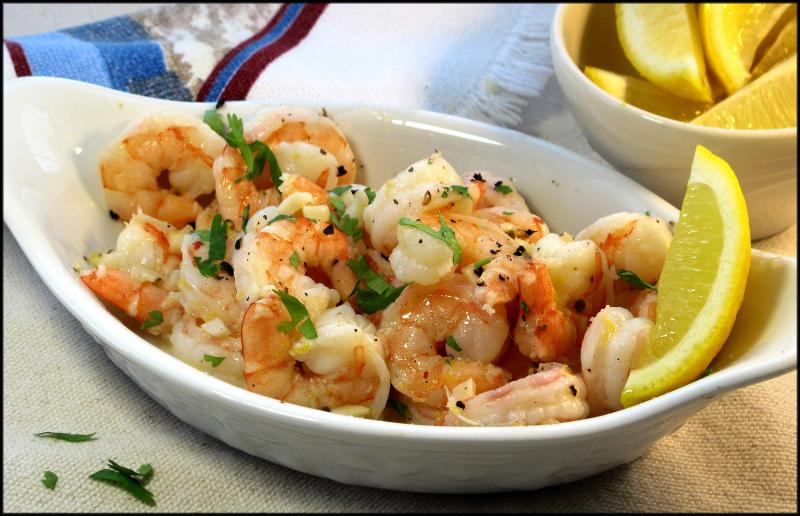Learn to make classic shrimp scampi
Many of us have ordered shrimp scampi from a restaurant menu without knowing the somewhat convoluted origin of the name for this delicious dish. The langoustine (Nephrops norgveicus) is a small, orange-pink shellfish, resembling its cousin, the lobster. Found in the chilly waters of the northern Atlantic Ocean and in the North Sea, they’re sometimes called Dublin Bay prawns or Norway lobster.
The succulent tail meat of the langoustine is known as scampi. This tail meat is very difficult to source and quite expensive for consumers in the American market. Hauled up to the surface in a version of lobster pots, langoustines are challenging to harvest from the frigid waters where they graze on the sea floor.
Most of the catch finds its way to Mediterranean countries, particularly France and Spain. And, their supply has dwindled to the point where strict quotas have been imposed. If you are lucky enough to find langoustines, they’ll most likely be offered frozen. Because they’re difficult to keep alive, they’re typically flash frozen while the boats are still at sea.
Since the original “scampi” were both rare and costly, restaurants turned to shrimp as a substitute for the langoustine tails. As a result, the term scampi has come to refer to the technique and type of sauce, rather than the specific ingredient.
The classic version of the recipe combines the flavors of garlic and lemon with a buttery wine sauce. Shelled shrimp (or langoustine tails, if you’re lucky) are tossed in the pan and simmered just long enough to cook through, without becoming as chewy as pencil erasers or rubber bands.
Most restaurants serve the shrimp over pasta (usually strands of linguine or fettuccine to hold the sauce), while others offer it in a casserole, topped with Parmesan cheese and along with slices of crusty bread to absorb the rich sauce.
Similar to the impossible “vegetarian burger” made without any beef, you’ll find chicken or veal scampi recipes, both without any call for langoustine tails. But, I won’t quibble with the ease of preparation and the bold flavor.
One way to highlight the shrimp flavor is to use the shells: after shelling the shrimp, toss the shells into a saucepan with some white wine and simmer for about 10 minutes. Strain the wine, discard the shells and use the infused wine for your scampi sauce.
If you elect to make a chicken scampi, the approach is the same, with one exception - the chicken is browned separately and then added to the sauce. Garnish with snipped parsley and grated Parmesan to complete the presentation on a bed of steamed rice.
One of the strongest flavors in this dish is garlic, which can be overpowering to some of us. I like to use a mixture of minced shallot and minced garlic to keep the sharp edges without making my breath smell like vampire repellent. To make these dishes without wine, substitute vegetable or chicken broth.
Although fresh shrimp are always preferable to the bags of frozen sold at the grocery, I always keep an emergency bag in my freezer for those times I have to pull together dinner without planning ahead - just make sure to select a bag labeled “raw”, not “cooked” or you’ll find yourself chewing on rubber bands.
Shrimp Scampi
1 T butter
1 T olive oil
3 minced garlic cloves
1/2 t Dijon mustard
1/4 t red pepper flakes
1/2 C white wine
juice and zest of 1 lemon
1 lb peeled, deveined shrimp
salt & pepper, to taste
2 T chopped parsley
1/4 C grated Parmesan cheese
Melt butter with oil in a large skillet over medium. Add garlic and cook until fragrant, about 1 minute. Add mustard, red pepper, wine, lemon zest and juice. Simmer, stirring often until blended and bubbling. Add shrimp and cook just until turning pink. Season to taste with salt and pepper. Garnish with parsley and Parmesan cheese. Serve over pasta, rice or in a bowl with crusty bread.
Chicken Scampi
1 lb chicken tenders
1/3 C flour
salt, to taste
1/2 t white pepper
1/2 t savory
1 T butter
1 T olive oil
3 minced garlic cloves
1/2 C white wine
2/3 C chicken broth
1/2 t Dijon mustard
1/4 t red pepper flakes
juice and zest of 1 lemon
2 T chopped parsley
1/4 C grated Parmesan cheese
Combine the flour, salt, pepper and savory on a paper plate. Lightly dredge the chicken in the flour mixture, shaking off any excess. Melt the butter in a nonstick skillet over medium and add the chicken pieces in a single layer. Cook, turning once or twice, until lightly browned; set aside. In the same skillet, add the olive oil and garlic; cook until softened, about 1 minute. Deglaze the pan with the wine, scraping up any browned bits from the bottom. Stir in the remaining ingredients and simmer until smooth. Return the cooked chicken to the pan, cover and cook until heated through, about 3 minutes. Serve over rice or pasta, garnished with parsley and Parmesan.





















































